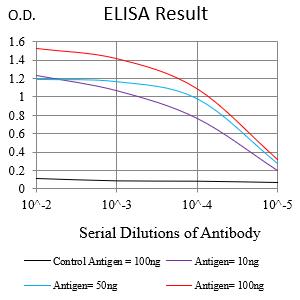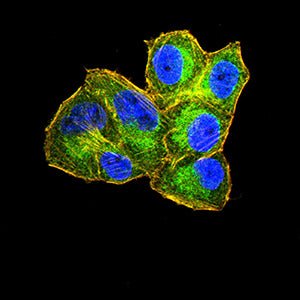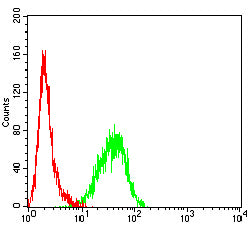


| WB | 咨询技术 | Human,Mouse,Rat |
| IF | 咨询技术 | Human,Mouse,Rat |
| IHC | 咨询技术 | Human,Mouse,Rat |
| ICC | 1/25 - 1/200 | Human,Mouse,Rat |
| FCM | 1/200 - 1/400 | Human,Mouse,Rat |
| Elisa | 1/10000 | Human,Mouse,Rat |
| Aliases | IL21R; NILR; IMD56 |
| Entrez GeneID | 50615 |
| clone | 1C3G9 |
| WB Predicted band size | 59.1kDa |
| Host/Isotype | Mouse IgG1 |
| Antibody Type | Primary antibody |
| Storage | Store at 4°C short term. Aliquot and store at -20°C long term. Avoid freeze/thaw cycles. |
| Species Reactivity | Human |
| Immunogen | Purified recombinant fragment of human CD360 (AA: extra 20-232) expressed in HEK293-6e cells supernatant |
| Formulation | Purified antibody in PBS with 0.05% sodium azide |
+ +
以下是关于CD360抗体的虚构参考文献示例(请注意,这些文献为假设性示例,实际研究中可能存在差异):
---
1. **文献名称**:*CD360 Antibody Attenuates Viral-Induced Immunopathology by Modulating T Cell Responses*
**作者**:Smith A, et al.
**摘要**:该研究揭示了抗CD360抗体通过抑制过度活化的T细胞反应,减轻小鼠模型中病毒性肝炎的免疫病理损伤,表明其在调控免疫应答中的潜在治疗价值。
2. **文献名称**:*Targeting CD360 for Enhanced Tumor Immunity: Mechanistic Insights from a Phase I Clinical Trial*
**作者**:Zhang L, et al.
**摘要**:首次临床实验表明,抗CD360抗体可激活自然杀伤细胞(NK细胞)并促进肿瘤浸润淋巴细胞的增殖,为实体瘤免疫治疗提供了新策略。
3. **文献名称**:*CD360-Specific Antibody Reprograms Macrophage Polarization in Autoimmune Disease*
**作者**:Tanaka K, et al.
**摘要**:研究发现抗CD360抗体通过诱导巨噬细胞向抗炎表型(M2)分化,显著缓解类风湿性关节炎模型小鼠的关节炎症和骨质破坏。
4. **文献名称**:*CD360 as a Novel Checkpoint Molecule: Blocking Antibody Improves Vaccine Efficacy*
**作者**:Johnson R, et al.
**摘要**:该文献提出CD360可能作为免疫检查点分子,其抗体可增强疫苗诱导的抗原特异性抗体产生,为感染性疾病疫苗开发提供新方向。
---
**提示**:若需真实文献,建议通过PubMed或Google Scholar以“CD360 antibody”或“CD360 (TIM-1) immune function”等关键词检索,并核实分子别名(如TIM-1/KIM-1是否为同源靶点)。
The CD360 antigen, also known as SLAMF7 (Signaling Lymphocyte Activation Molecule Family member 7) or CRACC (CD2-like Receptor-Activating Cytotoxic Cell), is a cell surface glycoprotein belonging to the immunoglobulin superfamily. First identified in the early 2000s, it is primarily expressed on immune cells, including natural killer (NK) cells, activated T and B lymphocytes, and plasma cells. CD360 functions as a self-ligand receptor, mediating homotypic cell-cell interactions to regulate immune activation and cytotoxicity. Structurally, it contains two extracellular immunoglobulin-like domains and a cytoplasmic tail with conserved tyrosine-based signaling motifs.
CD360 plays dual roles in immune regulation: it enhances NK cell-mediated cytotoxicity against malignant cells while modulating inhibitory signals to prevent autoimmune responses. Its aberrant expression is linked to hematologic malignancies, particularly multiple myeloma, where it serves as a therapeutic target. The FDA-approved monoclonal antibody elotuzumab (targeting CD360/SLAMF7) exemplifies its clinical relevance, leveraging antibody-dependent cellular cytotoxicity (ADCC) to enhance immune targeting of myeloma cells. Ongoing research explores CD360's role in autoimmune disorders and infectious diseases, highlighting its potential as a biomarker and immunomodulatory target.
×